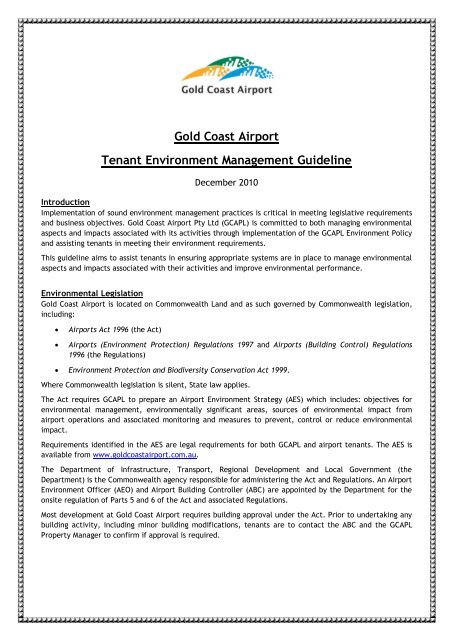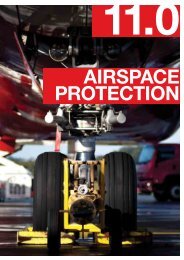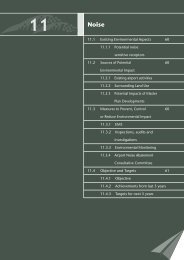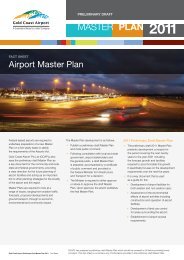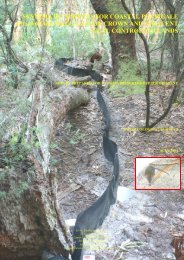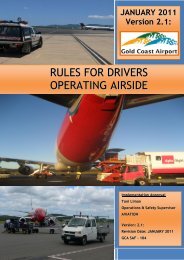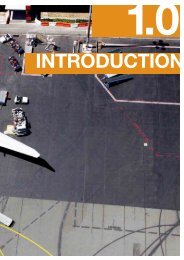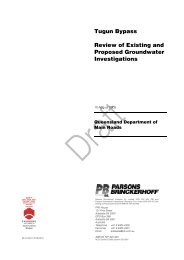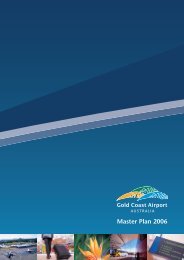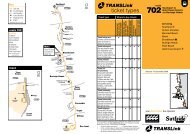Gold Coast Airport Tenant Environment Management Guideline
Gold Coast Airport Tenant Environment Management Guideline
Gold Coast Airport Tenant Environment Management Guideline
Create successful ePaper yourself
Turn your PDF publications into a flip-book with our unique Google optimized e-Paper software.
<strong>Gold</strong> <strong>Coast</strong> <strong>Airport</strong><br />
<strong>Tenant</strong> <strong>Environment</strong> <strong>Management</strong> <strong>Guideline</strong><br />
December 2010<br />
Introduction<br />
Implementation of sound environment management practices is critical in meeting legislative requirements<br />
and business objectives. <strong>Gold</strong> <strong>Coast</strong> <strong>Airport</strong> Pty Ltd (GCAPL) is committed to both managing environmental<br />
aspects and impacts associated with its activities through implementation of the GCAPL <strong>Environment</strong> Policy<br />
and assisting tenants in meeting their environment requirements.<br />
This guideline aims to assist tenants in ensuring appropriate systems are in place to manage environmental<br />
aspects and impacts associated with their activities and improve environmental performance.<br />
<strong>Environment</strong>al Legislation<br />
<strong>Gold</strong> <strong>Coast</strong> <strong>Airport</strong> is located on Commonwealth Land and as such governed by Commonwealth legislation,<br />
including:<br />
<br />
<br />
<strong>Airport</strong>s Act 1996 (the Act)<br />
<strong>Airport</strong>s (<strong>Environment</strong> Protection) Regulations 1997 and <strong>Airport</strong>s (Building Control) Regulations<br />
1996 (the Regulations)<br />
<strong>Environment</strong> Protection and Biodiversity Conservation Act 1999.<br />
Where Commonwealth legislation is silent, State law applies.<br />
The Act requires GCAPL to prepare an <strong>Airport</strong> <strong>Environment</strong> Strategy (AES) which includes: objectives for<br />
environmental management, environmentally significant areas, sources of environmental impact from<br />
airport operations and associated monitoring and measures to prevent, control or reduce environmental<br />
impact.<br />
Requirements identified in the AES are legal requirements for both GCAPL and airport tenants. The AES is<br />
available from www.goldcoastairport.com.au.<br />
The Department of Infrastructure, Transport, Regional Development and Local Government (the<br />
Department) is the Commonwealth agency responsible for administering the Act and Regulations. An <strong>Airport</strong><br />
<strong>Environment</strong> Officer (AEO) and <strong>Airport</strong> Building Controller (ABC) are appointed by the Department for the<br />
onsite regulation of Parts 5 and 6 of the Act and associated Regulations.<br />
Most development at <strong>Gold</strong> <strong>Coast</strong> <strong>Airport</strong> requires building approval under the Act. Prior to undertaking any<br />
building activity, including minor building modifications, tenants are to contact the ABC and the GCAPL<br />
Property Manager to confirm if approval is required.
<strong>Environment</strong>al <strong>Management</strong> Responsibilities of <strong>Tenant</strong>s<br />
All tenants are expected to have documented procedures/systems in place to manage environmental<br />
aspects and impacts from their activities, usually in the form of an <strong>Environment</strong>al <strong>Management</strong> Plan (EMP)<br />
or <strong>Environment</strong>al <strong>Management</strong> Systems (EMS) depending on the nature and scale of their operations.<br />
An EMP is usually simpler than an EMS and suitable for tenants whose activities do not have significant<br />
potential to impact on the environment. <strong>Tenant</strong>s whose activities have potential to cause significant<br />
environmental impact should consider implementing an EMS.<br />
Regardless of whether a tenants operations requires a EMP or an EMS, the following key elements should be<br />
considered:<br />
1. Introduction<br />
The introduction should provide an overview of the nature and scale of the tenants activities at<br />
<strong>Gold</strong> <strong>Coast</strong> <strong>Airport</strong> and define the scope of the EMP or EMS and how it will address the relevant<br />
environmental management requirements.<br />
2. Company <strong>Environment</strong> Policy<br />
<strong>Tenant</strong>s should have a clear documented Policy authorised by management defining the overall<br />
intentions, direction and commitment of the business in relation to environmental performance. As<br />
a minimum, the Policy should:<br />
Reflect the nature, scale and potential environmental impacts of the organisation;<br />
Include a commitment to prevention of pollution and continual improvement;<br />
Include a commitment to comply with applicable legal and other requirements to which the<br />
organisation subscribes; and<br />
Be communicated to all persons working for or on behalf of the organisation.<br />
3. Aspects and Impacts<br />
<strong>Tenant</strong>s should identify environmental aspects and impacts associated with their activities. Table 1<br />
provides some key environmental aspects and impacts associated with tenant and other airport<br />
operator’s activities. Although the information in this table addresses a large proportion of<br />
environmental risks on airport each tenant should identify the environmental aspects and impacts<br />
specifically associated with their activities. Once the relevant environmental aspects and impacts<br />
have been identified, those that can have a significant environmental impact should be<br />
determined. Significance is usually determined by an aspect having a legal or other requirements<br />
associated with it or which a risk assessment identifies as being of a medium, high or extreme risk.<br />
For guidance in relation to risk assessments refer to AS/NZS ISO31000:2009 Risk <strong>Management</strong> –<br />
Principles and <strong>Guideline</strong>.
Table 1: Example Aspects and Impacts Register with Key <strong>Airport</strong> Related Aspects and Impacts<br />
Activity Aspect Impact Control(s)<br />
Importation of Contaminated Fill<br />
Construction<br />
Demolition<br />
Maintenance<br />
Disturbance of Acid Sulphate Soils<br />
Construction<br />
Demolition<br />
Maintenance<br />
Spill<br />
Refuelling activities<br />
Emptying of aircraft sewerage<br />
Chemical use<br />
Maintenance<br />
Construction<br />
Leaks (underground)<br />
UST<br />
Fuel lines<br />
Sewer lines<br />
Incorrect Disposal of Waste<br />
Construction<br />
Demolition<br />
Maintenance<br />
Operations – terminal, aircraft,<br />
offices<br />
Erosion and Sedimentation<br />
Vegetation removal<br />
Construction<br />
Maintenance<br />
Incorrect Storage, Handling and use of<br />
Hazardous Materials<br />
Herbicide use<br />
Cleaning<br />
Maintenance<br />
Construction activities (i.e. water<br />
treatment – dewatering)<br />
Demolition<br />
Chemical stores<br />
Introduction/Invasion of Weeds and Feral<br />
Animals<br />
Construction<br />
Maintenance<br />
Dewatering<br />
Construction<br />
Flora/Fauna Disturbance and Land Clearing<br />
Construction<br />
Maintenance<br />
Off-track vehicular movements<br />
Storage of equipment in<br />
unauthorised areas<br />
Fire<br />
Fire Training<br />
Natural Ignition<br />
Dust<br />
Construction<br />
Demolition<br />
Maintenance<br />
Stockpiling<br />
Vehicular movements on dirt roads<br />
Air Emissions (onsite/direct)<br />
Vehicular/ Aircraft/Plant<br />
operations<br />
Painting/ Spray painting<br />
Use of volatile chemicals<br />
Refuelling activities<br />
Noise<br />
Ground based Aircraft/ vehicle<br />
movements<br />
Construction<br />
Demolition<br />
Maintenance activities<br />
Soil or Land Disturbance<br />
Construction<br />
Demolition<br />
Maintenance<br />
Consumption of Natural Resources<br />
Construction<br />
Demolition<br />
General <strong>Airport</strong>/ Building<br />
Operations<br />
Vehicle and ground based aircraft<br />
movements<br />
Operations of mobile and<br />
stationary plant.<br />
Leachate of contaminated material into soil,<br />
surface and or groundwater<br />
Generation of sulphuric acid and flow on<br />
effects to soil, surface water, groundwater,<br />
flora and fauna<br />
Discharge of fuel, chemicals, herbicides or<br />
sewerage to soil, surface water, groundwater<br />
and flora/fauna habitat<br />
Discharge of fuel or sewerage to soil, surface<br />
water, groundwater and flora/fauna habitat<br />
Waste entering soil, waterways or drains<br />
resulting in contamination to soil, surface and<br />
or groundwater<br />
Land degradation and or sedimentation of<br />
waterways<br />
Discharge of hazardous materials to soil,<br />
surface and or groundwater<br />
Introduction, invasion or establishment of<br />
weeds or feral animals on airport land or<br />
waterways<br />
Change to hydrology effecting terrestrial<br />
and/or aquatic habitats/species<br />
Removal or disturbance to native flora/fauna<br />
including those with legislative significance.<br />
Fire ignition and spread into native<br />
flora/fauna habitat.<br />
Discharge of dust to air<br />
Emissions to air<br />
Noise emissions<br />
Disturbance to places or items of Cultural<br />
Heritage significance<br />
Reduction of natural resources and emissions<br />
to air including greenhouse gas emissions and<br />
waste generation<br />
Soil, Surface and Groundwater<br />
Contamination<br />
Generation of sulphuric acid and<br />
mobilisation of metals contaminating<br />
soil, surface and groundwater and<br />
stress or mortality on flora/fauna<br />
Soil, surface and groundwater<br />
contamination and stress or mortality<br />
to native flora/fauna species.<br />
Soil, surface and groundwater<br />
contamination and stress or mortality<br />
to native flora/fauna species.<br />
Soil, Surface and Groundwater<br />
Contamination.<br />
Reduction in environmental values of<br />
land and contamination of surface<br />
waters with sediment<br />
Soil, Surface and Groundwater<br />
Contamination<br />
Competition and predation of native<br />
flora/fauna species.<br />
Flora dieback or stress on aquatic and<br />
terrestrial flora/fauna.<br />
Stress, injury or loss of native<br />
flora/fauna species resulting.<br />
Loss or injury of native flora/fauna<br />
species.<br />
Human/ animal health issues and a<br />
reduction in aesthetics and air quality.<br />
Greenhouse gas emissions and human/<br />
animal health issues. Deterioration of<br />
air quality.<br />
Public nuisance and impacts to fauna.<br />
Damage and disturbance of Cultural<br />
Heritage items and/ or places.<br />
Depletion of natural resources and<br />
emissions to air including greenhouse<br />
gas emissions and waste generation.<br />
Significant aspects<br />
and impacts need<br />
to appropriate<br />
controls<br />
implemented as per<br />
item 8. These<br />
controls should be<br />
listed here.
4. Legal and other requirements<br />
<strong>Tenant</strong>s should ensure they are aware of their legal requirements specifically relating to the<br />
identified significant environmental aspects and impacts. This includes legislation identified above<br />
and environmental requirements specified in tenant leases with GCAPL.<br />
A process for evaluating compliance against the legal and other requirements identified should be<br />
implemented.<br />
5. Resources Roles and Responsibility<br />
<strong>Tenant</strong>s should ensure adequate resources necessary to establish, implement, maintain and<br />
improve their EMP or EMS. Roles and responsibilities should also be defined and communicated to<br />
facilitate effective environmental management.<br />
6. Training<br />
Training is critical in ensuring effective implementation of procedures developed to minimise<br />
environmental risks. Training can include inductions, tool box talks and external training.<br />
<strong>Tenant</strong>s need to ensure any person performing tasks on their behalf (e.g. staff, contractors etc.)<br />
that have the potential to cause significant environmental impact(s) is competent on the basis of<br />
appropriate education, training or experience, and ensure they are aware of their environmental<br />
aspects, impacts and procedures associated with their work. Training records should be kept.<br />
7. Documentation & Control of Documents and Records<br />
The EMP/EMS needs to identify the documents necessary to ensure effective environmental<br />
management that relate to the identified significant aspects and impacts. These may include the<br />
Company <strong>Environment</strong> Policy, incident response procedure, waste management procedure etc. and<br />
relevant records including training records.<br />
Documents required by the EMP/EMS should be controlled and approved for adequacy, reviewed<br />
regularly, be current and have a revision date, available at points of use and remain legible.<br />
Records external to the EMP/EMS necessary to demonstrate conformity to environmental<br />
management requirements also need to be identifiable, retrievable and legible.<br />
8. Operational Control<br />
<strong>Tenant</strong>s should have documented operational procedures which are in line with their <strong>Environment</strong><br />
Policy and environmental aspects.<br />
The relevant operating procedures and/or criteria should be listed as controls against the identified<br />
significant aspects (see table 1). Appendix A of the <strong>Gold</strong> <strong>Coast</strong> <strong>Airport</strong> 2009 <strong>Airport</strong> <strong>Environment</strong><br />
Strategy also contains some detail which may assist in developing these procedures.
9. Emergency Preparedness and Response<br />
<strong>Environment</strong>al emergencies associated with airport operations include large fuel/oil spills, bush<br />
fires and aircraft incidents impacting on the environment. In case of emergency, contact the<br />
<strong>Airport</strong> Safety Officer on 0407 755 722.<br />
Each tenant should have an emergency response procedure which includes responding to<br />
environmental emergencies that may arise as a result of tenant activities. This procedure should<br />
include contacting the <strong>Airport</strong> Safety Officer.<br />
All minor spills should also be reported to the <strong>Airport</strong> Safety Officer. <strong>Tenant</strong>s should have<br />
appropriate spill response equipment and procedures to respond to minor spills associated with<br />
their activities. Staff should be trained in emergency response.<br />
10. Monitoring, Measurement and Audit<br />
<strong>Tenant</strong>s should monitor the performance of controls associated with their significant environmental<br />
aspects. This may include monitoring performance against operating procedures, resource use and<br />
monitoring impacts on land, surface and groundwater associated with their activities.<br />
Auditing is the key process by which implementation of the EMP/EMS can be monitored.<br />
<strong>Tenant</strong>s should conduct internal audits at planned intervals to determine whether their EMP/EMS is<br />
being properly implemented and maintained.<br />
GCAPL also undertake regular tenant environmental audits. Frequency of audits depends on the<br />
potential environmental risks posed by tenant activities. Those tenants having high risk activities,<br />
for example, maintenance workshops, and storage and handling fuel and other hazardous materials<br />
are audited annually. Medium and low risk tenants are audited every 2-3 years and on an as needs<br />
basis respectively.<br />
<strong>Tenant</strong> audits provide a good opportunity to gain further information and guidance regarding your<br />
environment performance from GCAPL.<br />
Non-conformance identified in GCAPL audits are to be addressed in writing, within specified<br />
timeframes.<br />
11. Non-conformance, Corrective and Preventative Action<br />
This section should detail how actual and potential non-conformances are identified and dealt with<br />
including the process for taking corrective and preventative actions. Common sources for<br />
identifying non-conformances include audits, incidents and inspections. This section should also<br />
deal with how complaints by external parties are handled and followed up.<br />
12. Review<br />
The EMP/EMS should be reviewed regularly to ensure its continuing suitability, adequacy,<br />
effectiveness and to assess opportunities for improvement.
Useful Information Sources<br />
GCAPL Website – Contains the AES, Master Plan, Development <strong>Guideline</strong>s.<br />
www.goldcoastairport.com.au<br />
**************************************************************************<br />
Commonwealth Department of Infrastructure and Transport Website<br />
www.infrastructure.gov.au<br />
**************************************************************************<br />
ComLaw Website – Access to relevant Commonwealth Legislation<br />
www.comlaw.gov.au<br />
**************************************************************************<br />
Global Spill Website – Supply and servicing of spill response equipment<br />
www.globalspill.com.au<br />
**************************************************************************<br />
SAI Global Website – Access to AS/NZS ISO 14001:2004 <strong>Environment</strong>al <strong>Management</strong> Systems – Requirements<br />
with guidance for use & AS/NZS ISO31000:2009 Risk <strong>Management</strong> – Principles and <strong>Guideline</strong>s<br />
www.saiglobal.com<br />
**************************************************************************<br />
Key Contacts<br />
<strong>Gold</strong> <strong>Coast</strong> <strong>Airport</strong> Pty Ptd<br />
<strong>Management</strong> Office<br />
(07) 5589 1100 – General Enquiries<br />
<strong>Airport</strong> Safety Officer 0407 755 722 - Emergency Contact<br />
Property Manager<br />
(07) 5589 1136 - Leasing Enquiries<br />
Concessions Manager<br />
(07) 5589 1106 - Terminal Commercial Enquiries<br />
<strong>Environment</strong> Manager (07) 5589 1108 - <strong>Environment</strong>al Enquiries<br />
Department of Infrastructure, Transport, Regional Development and Local Government<br />
<strong>Airport</strong> <strong>Environment</strong> Officer<br />
<strong>Airport</strong> Building Controller<br />
(07) 5536 8426 - <strong>Environment</strong>al Regulatory Enquiries<br />
(07) 3216 3040 - Development Enquiries<br />
Notice<br />
While all care has been taken in preparing this document, GCAPL accepts no liability whatsoever to any<br />
person who in any way relies on any information contained in this guide.<br />
© Copyright<br />
Copyright in this document vests in GCAPL. No section or element of this document may be removed from,<br />
reproduced, electronically stored or transmitted in any form without the written permission of GCAPL other<br />
than for the sole purpose of reviewing its contents.


